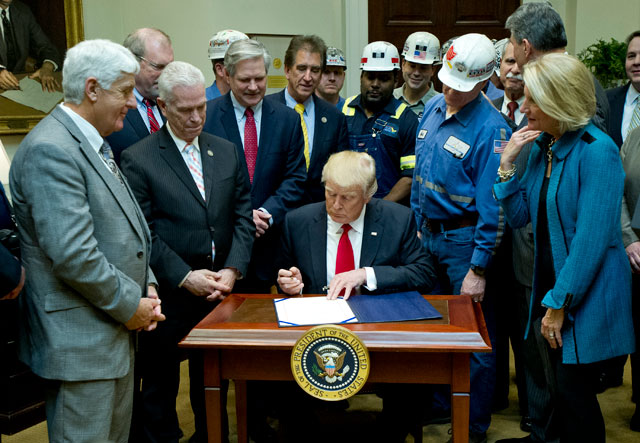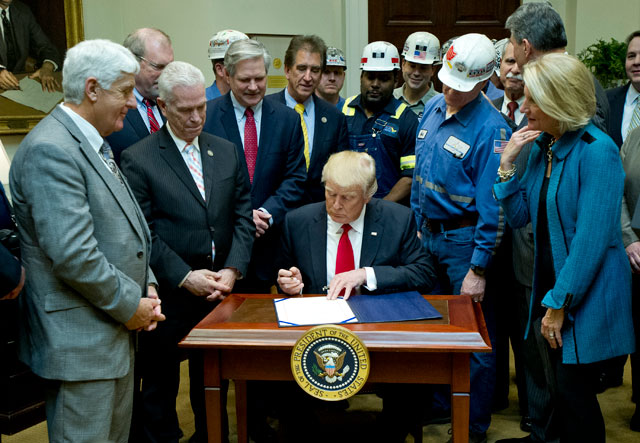
 President Donald Trump signs H.J. Res. 38, disapproving the Stream Protection Rule in the Roosevelt Room of the White House on February 16, 2017, in Washington, DC. Trump might not be able to save coal, but he can roll back the industry regulations that existed under President Obama. (Photo: Ron Sachs-Pool / Getty Images)
President Donald Trump signs H.J. Res. 38, disapproving the Stream Protection Rule in the Roosevelt Room of the White House on February 16, 2017, in Washington, DC. Trump might not be able to save coal, but he can roll back the industry regulations that existed under President Obama. (Photo: Ron Sachs-Pool / Getty Images)
On the campaign trail, Donald Trump consistently claimed that he would revive the coal industry, and since becoming president, he has consistently declared victory. “Since the fourth quarter of last year until most recently, we’ve added almost 50,000 jobs in the coal sector,” Donald Trump announced last June. “In the month of May alone, almost 7,000 jobs.”
Preliminary government data shows that Trump’s efforts to increase mining jobs have failed in most coal-producing states.
Trump was presumably repeating a number he had heard mentioned by EPA Administrator Scott Pruitt, who proudly touted the 50,000 figure in various media appearances last year. Pruitt’s numbers are, in fact, way off. According to data from the Bureau of Labor Statistics, from the beginning of 2017 through that May, about 33,000 “mining and coal” jobs were created. That’s obviously much lower than 50,000. Plus, most of those 33,000 jobs actually came from a subcategory called “support activities for mining.” When Trump made that statement, the actual number of new coal jobs was about 1,000. Now it’s about 1,200. Preliminary government data recently obtained by Reuters shows that Trump’s efforts to increase mining jobs have failed in most coal-producing states.
In addition to coal production dropping off, solar and wind power are now a cheaper option, and more Americans are becoming aware of coal’s devastating environmental impact. Even early Trump supporter Robert Murray, CEO of Murray Energy, the country’s biggest privately held coal company, admitted that the president “can’t bring mining jobs back.”
Regulation Rollbacks
Trump might not be able to save coal, but he can roll back the industry regulations that existed under Obama, and that’s what his administration has been doing since taking office. Now we know that many of these rollbacks were features of an “action plan” that the aforementioned Murray sent to Mike Pence during the early days of the Trump era. Murray’s memo was obtained by Rhode Island Sen. Sheldon Whitehouse and first reported by the New York Times earlier this year. “Coal baron Bob Murray, CEO of one of the largest polluters in the country, has given pages of marching orders to President Trump,” Whitehouse declared last November. A review of the “action plan” by the Associated Press concluded that Trump had followed through on roughly half of Murray’s suggested agenda. The moves include pulling out of the Paris Agreement and killing Obama’s plan to reduce emissions from coal plants.
In addition to environmental rollbacks, the administration has also targeted a number of coal industry safety regulations. Trump’s Mine Safety and Health Administration (MSHA), which is run by retired coal mining executive David Zatezalo, is reconsidering regulations that protect miners from breathing coal, rock dust and diesel exhaust. Breathing coal and rock dust can cause black lung disease and breathing diesel exhaust can cause cancer.
“We believe the respirable dust rule that was promulgated under the previous administration is reasonable and beneficial to miners,” said Phil Smith, communications and governmental affairs director of the United Mine Workers. “We see no reason to change it.”
Last February, Trump signed Executive Order 13777, which directs federal agencies to review regulations and determine what can be scrapped. This review process calls on coal industry stakeholders to assist the MSHA in identifying regulations that should be repealed.
Black lung disease appears to be making a comeback in Appalachia. In fact, the disease has actually become more dangerous.
In addition to these efforts, the Department of Labor has announced plans it’s beginning a new compliance assistance program for mines. In theory, the program is supposed to improve safety by providing further training for new miners. However, critics like Smith point out that the program contains fatal flaws. Under the new program, MSHA officials are being instructed to leave their credentials behind before entering the mines. This means that they can’t issue safety violations on the spot and lack the ability to enforce actual laws. By extension, they are unable to issue an order to remove workers from a mine that is deemed to be unsafe.
After Record Low Under Obama, Mining Deaths Are Now Rising
It’s a curious time to reduce mining safety protocols. For starters, workplace fatalities are actually increasing in coal mining. After hitting a record low of eight in 2016, the death rate surged to 15 last year. “We have seen a significant turnover in the workforce over the last several years, as older miners retire and younger, more inexperienced workers replace them,” Smith told Truthout. “Many of the companies are doing a poor job at training these new workers, both in the case of task training on specific pieces of equipment and general mine safety training.” Nearly all the miners who died in 2017 were new to the job.
Zatezalo, who was nominated last September and confirmed the following month, is now in charge of policing violations — but he has his own track-record of safety infractions. Zatezalo is the former CEO of Rhino Resource Partners. In 2011, Rhino had to pay out $44,500 in fines after a foreman was killed in a West Virginia mine. That same year, MSHA sought a federal court injunction against the company after learning that its employees were giving miners advance notice of safety inspections.
Black Lung Is Back
The fatal impact of coal mining certainly can’t be measured by workplace fatalities alone, as many miners later die from illnesses they developed on the job. In addition to the increasing number of workplace deaths, black lung disease appears to be making a comeback in Appalachia. In fact, the disease has actually become more dangerous, infecting miners earlier than ever before and in a deadlier form. Experts believe this might be a result of miners working longer hours and new methods of extraction.
Paula Jean Swearengin, who is running against the incumbent, conservative Democrat Sen. Joe Manchin in West Virginia, watched her family get sick as a result of mining. “My stepdad and my dad had both worked in the coal mines,” she told In These Times. “My grandfather suffocated of black lung. My stepdad had black lung, heart disease and open-heart surgery. My dad passed away in 2005. He had black lung and lung cancer. Most of my uncles have black lung.”
Black lung is currently being found in about 1 out of every 14 miners with more than 25 years on the job, compared to a rate of 1 out of every 25 miners during the late ’90s. “We believed that modern mining technologies and dust controls, which have been in place for decades, had eliminated this scourge,” Robert Cohen, a pulmonologist who specializes in the disease, wrote in 2016. “We were wrong.”
A 2016 National Institute for Occupational Safety and Health (NIOSH) study uncovered the most cases of black lung that it had identified since 2010: 60 cases over a 20-month period. An ongoing investigation by NPR shows that the problem is actually much, much worse. NIOSH researchers reported 99 cases of advanced black lung from 2010 on. NPR’s investigation came up with a number that is almost 20 times higher than that: 2,000 cases since 2010.
Pending Industry Lawsuits
Although the Trump administration’s pro-industry pattern seems clear, it remains to be seen how it will deal with two lawsuits filed against MSHA by members of the coal industry in 2014 and 2015. The legal action takes aim at the government’s “pattern of violations” rule. Under the rule, which has technically existed for 40 years but was barely used until the Obama era, mines with major recurring safety problems are subjected to a stricter safety protocol and potentially shut down.
Last December, a judge ruled that the Trump administration would have at least three more months to work out a deal with the industry lawyers. However, the fact that the government isn’t standing behind the “pattern of violations” rule seems to indicate that it could be another area where safety is sacrificed. On top of that, the attorneys are now up against Zatezalo, a man whose former company received two warning letters under the program.
Trump’s vision of a coal comeback might be a fantasy, but its dangers are very real.
Join us in defending the truth before it’s too late
The future of independent journalism is uncertain, and the consequences of losing it are too grave to ignore. To ensure Truthout remains safe, strong, and free, we need to raise $29,000 in the next 36 hours. Every dollar raised goes directly toward the costs of producing news you can trust.
Please give what you can — because by supporting us with a tax-deductible donation, you’re not just preserving a source of news, you’re helping to safeguard what’s left of our democracy.